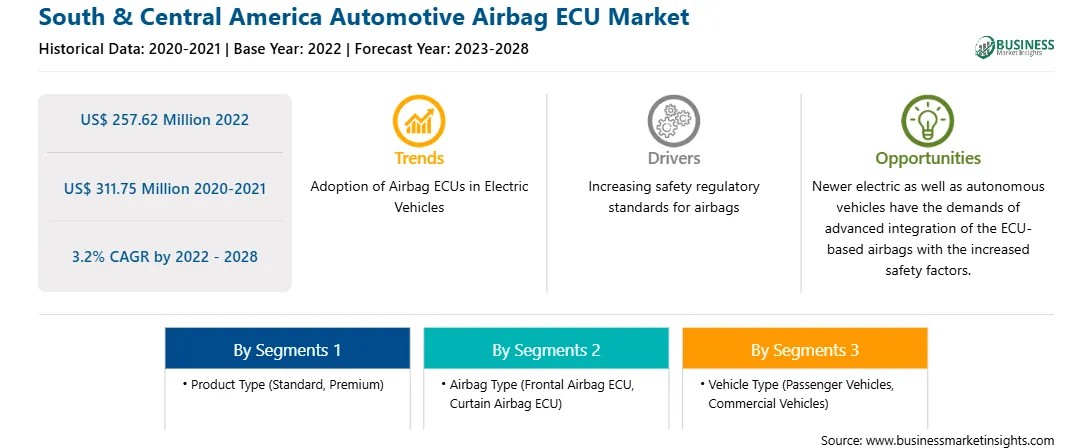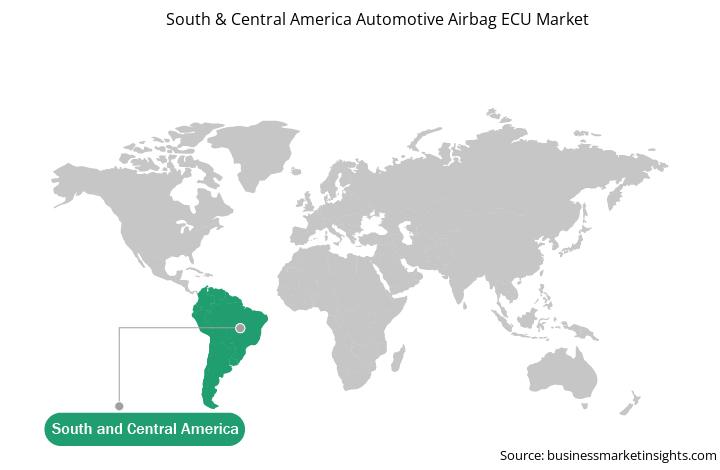The automotive airbag ECU market in South & Central America is expected to grow from US$ 257.62 million in 2022 to US$ 311.75 million by 2028. It is estimated to grow at a CAGR of 3.2% from 2022 to 2028.
Ongoing Technological Advancements in Airbag ECUs
With the rapid expansion of clientele, manufacturers in the automotive sector are primarily focusing on enhancing fuel and cost efficiencies, driving experience, and overall passenger and driver safety. Airbag control units (ACU) play a central role in the new E/E architecture and adopt functions that provide more protection for occupants. Control units provide the highest crash safety standards and reliable airbag deployment. Apart from sensors, ACUs receive signals from pressure satellites, which detect and report the pressure wave of a collision. Advancements in airbag and ECUs technologies are propelling their adoption across passenger vehicles. Continental AG offers ECUs converted into software-based products in reorganizing the E/E architecture with centralization and a few high-performance computers.
Computer-operated dual airbags or dual-stage airbags are deployed at two vehicle speed limits. In less severe accidents, airbags are deployed in a lower first stage, usually ~70.0% of full force. However, they deployed at both stages in more severe accidents. Further, side airbags effectively protect drivers and passengers from crucial head injuries caused by side-impact collisions. In September 2019, Hyundai Mobis developed a “Safety Integrated Control Module” that ensures greater efficiency and safety in the operations of automotive safety devices. The new product combines two separate ECUs for airbags and electronic seatbelts into a single unit.
Market Overview
The automotive airbag ECU market in SAM is segmented into Brazil, Argentina, and the rest of SAM. The rest of SAM countries include Chile, Colombia, Guatemala, and Peru. SAM economies mainly depend on imported goods and commodities. However, with the rise in FDIs, several industries are coming up and contributing substantially to the respective country’s GDP. Rapid urbanization, rising environmental concerns, traffic congestion, evolving mobility patterns, and government initiatives for the provision of safety systems across vehicles are expected to drive the demand for airbag ECUs in SAM during the forecast period.
In Brazil, 2,851 electric cars were sold in 2021, representing only 0.14% of light vehicle sales. There are no stringent legislations related to the electrification of vehicles. However, PROCONVE requirements ask for enhancements in the engine technology and lays emphasis on rising the share of electric vehicles in the country. Rise in the adoption of electric vehicles and increase in the manufacturing of passenger cars in the nation increase the demand for airbags across the country. Brazil is one of a few nations that have seen an increase in automobile registrations and production. The number of passenger automobiles manufactured in the nation was 2.45 million in 2019, up from 2.38 million in 2018, according to National Association of Motor Vehicle Manufacturers. Rising disposable income of population, increasing awareness of the road safety need, high rate of traffic accidents, and well-coordinated government regulations fuel the growth of the automotive airbags ECU market in Brazil. The installation of a front airbag and anti-lock braking system has been mandated for all new vehicles since January 2014. In the beginning of 2020, Latin NCAP will conduct side impact tests on all newly released passenger vehicles in the nation. From the beginning of 2023, side impact tests for vehicles will be required nationwide. Therefore, the market for side airbags and curtain airbags in Brazil is anticipated to grow in the coming years.
Strategic insights for the South & Central America Automotive Airbag ECU provides data-driven analysis of the industry landscape, including current trends, key players, and regional nuances. These insights offer actionable recommendations, enabling readers to differentiate themselves from competitors by identifying untapped segments or developing unique value propositions. Leveraging data analytics, these insights help industry players anticipate the market shifts, whether investors, manufacturers, or other stakeholders. A future-oriented perspective is essential, helping stakeholders anticipate market shifts and position themselves for long-term success in this dynamic region. Ultimately, effective strategic insights empower readers to make informed decisions that drive profitability and achieve their business objectives within the market. The geographic scope of the South & Central America Automotive Airbag ECU refers to the specific areas in which a business operates and competes. Understanding local distinctions, such as diverse consumer preferences (e.g., demand for specific plug types or battery backup durations), varying economic conditions, and regulatory environments, is crucial for tailoring strategies to specific markets. Businesses can expand their reach by identifying underserved areas or adapting their offerings to meet local demands. A clear market focus allows for more effective resource allocation, targeted marketing campaigns, and better positioning against local competitors, ultimately driving growth in those targeted areas.South & Central America Automotive Airbag ECU Strategic Insights

South & Central America Automotive Airbag ECU Report Scope
Report Attribute
Details
Market size in 2022
US$ 257.62 Million
Market Size by 2028
US$ 311.75 Million
Global CAGR (2022 - 2028)
3.2%
Historical Data
2020-2021
Forecast period
2023-2028
Segments Covered
By Product Type
By Airbag Type
By Vehicle Type
Regions and Countries Covered
South and Central America
Market leaders and key company profiles
South & Central America Automotive Airbag ECU Regional Insights

South & Central America Automotive Airbag ECU Market Segmentation
The South & Central America automotive airbag ECU market is segmented into product type, airbag type, vehicle type, and country.
The product type segment is bifurcated into standard and premium. Premium segment is expected to lead the automotive airbag ECU market in 2022. Based on airbag type, the automotive airbag ECU market can be bifurcated into frontal airbag ECU and Curtain airbag ECU. Frontal airbag ECU segment is expected to lead the automotive airbag ECU market in 2022. Based on vehicle type, the market is segmented into passenger vehicles and commercial vehicles. The commercial segment is expected to hold the largest market share in 2022. Based on country, the market is segmented into Brazil Argentina, and the Rest of South & Central America. Brazil is expected to dominate the market in 2022. Aptiv; Autoliv Inc.; Continental AG; Denso Corporation; HELLA GmbH and Co. KGaA; Hyundai Mobis; Mitsubishi Electric Corporation; Robert Bosch GmbH; and ZF Friedrichshafen AG are the leading companies operating in the automotive airbag ECU market in the region.
The South & Central America Automotive Airbag ECU Market is valued at US$ 257.62 Million in 2022, it is projected to reach US$ 311.75 Million by 2028.
As per our report South & Central America Automotive Airbag ECU Market, the market size is valued at US$ 257.62 Million in 2022, projecting it to reach US$ 311.75 Million by 2028. This translates to a CAGR of approximately 3.2% during the forecast period.
The South & Central America Automotive Airbag ECU Market report typically cover these key segments-
The historic period, base year, and forecast period can vary slightly depending on the specific market research report. However, for the South & Central America Automotive Airbag ECU Market report:
The South & Central America Automotive Airbag ECU Market is populated by several key players, each contributing to its growth and innovation. Some of the major players include:
The South & Central America Automotive Airbag ECU Market report is valuable for diverse stakeholders, including:
Essentially, anyone involved in or considering involvement in the South & Central America Automotive Airbag ECU Market value chain can benefit from the information contained in a comprehensive market report.